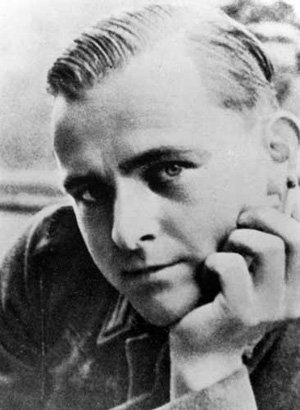Willi Graf (Willi Graf)

Willi Graf (2 January 1918 in Kuchenheim near Euskirchen – 12 October 1943 in Munich) was a Roman Catholic member of the White Rose (Weiße Rose) resistance group in Nazi Germany. Willi Graf’s family moved to Saarbrücken in 1922, where his father ran a wine wholesaler, and was the manager of the Johannishof, the second largest banquet hall in Saarbrücken. Graf went to school at the Ludwigsgymnasium. It was not long before he joined, at the age of eleven, the Bund Neudeutschland, a Catholic youth movement for young men in schools of higher learning, which was banned after Hitler and the Nazis came to power in 1933. In 1934, Graf joined the Grauer Orden (“Grey Order”), another Catholic movement which became known for its anti-Nazi rhetoric. It, too, was banned and for this reason, it formed many splinter youth groups.
Willi Graf showed conviction in his beliefs from a young age. Although compulsory at the time, he refused to associate with the Hitler Youth. While other future members of the White Rose initially embraced the Hitler Youth, Graf never did so. Moreover, in his address book he crossed out the names of friends who had joined the Hitler Youth. In 1935, at the age of 17, Graf and a few friends marched in an annual May Day parade. The parade was dominated by swastikas, brown-shirted Hitler Youth troops marching in formation, and “Sieg Heils.” However, Graf and his friends marched under their tattered school flag, making great effort to stand out from their peers. They did not don any swastikas, or participate in any of the “Sieg Heil” salutes. After his Abitur, the German equivalent of Baccalauréat, in 1937, Willi Graf did his six month Reichsarbeitsdienst and afterwards began his medical studies. In 1938, he was arrested along with other members of the Grauer Orden and charged by a court in Mannheim with illegal youth league activities–the Bünde having been banned–in relation with his unlawful field trips, camping excursions and other meetings with the Grauer Orden. The charges were later dismissed as part of a general amnesty declared to celebrate the Anschluss. The detention had lasted three weeks. His time in jail did not weaken his decision to participate in anti-Nazi activities or organizations.
On 18 February 1943, Willi Graf, along with his sister Anneliese, was seized in Munich. On 19 April 1943, he was sentenced to death at the Volksgerichtshof for high treason, Wehrkraftzersetzung (undermining the troops’ spirit), and furthering the enemy’s cause. Willi Graf was beheaded on 12 October 1943 at Stadelheim Prison in Munich, after six months of solitary confinement. During this 6-month period the Gestapo tried to extract information from Graf about other White Rose members and other anti-Nazi movements. While under interrogation Graf yielded no names, and took on blame for White Rose activities in order to protect others who had not yet been arrested. His grave is in the St. Johann Cemetery in Saarbrücken. Seven schools in Germany have been named after him, among them the Willi-Graf-Gymnasium in Munich and Saarbrücken-St. Johann; a student residence in Munich also honours Graf by bearing his name.
Born
- January, 02, 1918
- Euskirchen, Germany
Died
- October, 12, 1943
- Munich, Germany
Cemetery
- Saint Johann Cemetery
- Saarland, Germany


